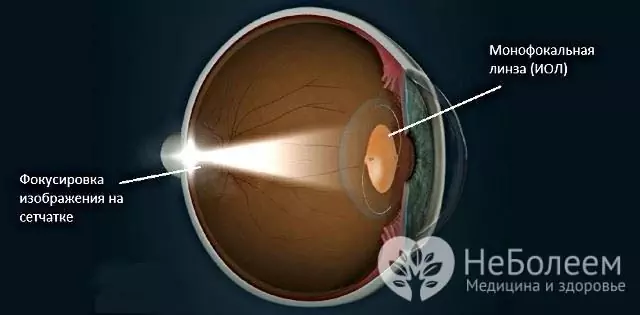- Author Rachel Wainwright [email protected].
- Public 2023-12-15 07:39.
- Last modified 2025-11-02 20:14.
Afakia
The content of the article:
- Causes and risk factors
- Symptoms
- Diagnostics
-
Treatment
Treatment of aphakia in children
- Possible complications and consequences
- Forecast
- Prevention
Afakia is a pathological condition characterized by the absence of a lens in the eyeball.
Attention! Photo of shocking content.
Click on the link to view.
Causes and risk factors
Afakia is congenital and acquired. Congenital absence of the lens is extremely rare. Much more often the lens is removed during surgery for dislocation or cataract. With penetrating wounds of the eyeball, spontaneous loss of the lens may occur in some cases.
Symptoms
After the loss of the lens, the refraction of the eye changes by about 9-12 diopters, as a result of which the visual acuity drops sharply (up to hundredths of a diopter).
In the first weeks after removal of the lens, pronounced reverse astigmatism is noted, in which the meridian with the strongest refractive index of light rays (main) is located in the sector ± 30 ° from the horizontal or horizontally along the 0-180 ° axis. After 1.5-2 months, the severity of astigmatism is significantly reduced, it becomes stable. In some patients, astigmatism disappears completely.
The anterior chamber of the affected eye is deep. When the eyeball moves, tremors of the iris (iridodonesis) are noticeable. A scar is visible on the cornea, which remained after the surgery.
Diagnostics
Diagnosis of congenital aphakia is carried out on the basis of characteristic clinical signs and anamnesis data.
Treatment
Correction of aphakia is performed no earlier than one month after removal of the lens. At first, glasses are selected for the patient for distance and only after full adaptation to them glasses are prescribed for him to work at close range. In the presence of astigmatism, special care should be taken to correct it.
The absence of the lens in only one eyeball (monocular aphakia) is a contraindication for spectacle correction, since a spectacle lens with high optical power causes the development of aniseikonia. In this state, the size of the image of the observed object on the retina of each eye is different, as a result of which binocular vision is impaired. Therefore, with monocular aphakia, vision correction is carried out using contact lenses.
Recently, intraocular correction has been increasingly used to treat aphakia. The essence of the method is to replace the lost lens with an artificial lens of the necessary optical power, which is surgically implanted into the eyeball.

Intraocular correction of aphakia consists in implanting a lens of the required optical power into the eyeball
Treatment of aphakia in children
The state of aphakia in children requires careful correction to ensure the highest possible visual acuity. As children grow, the size of the eyeball changes, respectively, its optical power changes. In connection with the above, children should be regularly examined by an ophthalmologist; contact lenses or glasses should be replaced in a timely manner.
Most ophthalmologists agree that soft silicone contact lenses are best used to correct aphakia in children.

A child with aphakia should be regularly examined by an ophthalmologist in order to timely replace lenses and glasses
In the first years of a child's life, intraocular vision correction is inappropriate: as the child grows, it will be necessary to replace the intraocular lens repeatedly. In addition, the implant can have a negative impact on the development of the eyeball, slowing down its growth.
Possible complications and consequences
In the complete absence of the lens, the vitreous body is retained only by the anterior borderline membrane. This leads to the fact that after a while in the area of the pupil, it protrudes forward, forming a hernia of the vitreous body. The progression of the hernia causes the rupture of the anterior border membrane and the exit of the vitreous fibers into the anterior chamber of the eye (complicated vitreous hernia).
Other complications of aphakia are corneal edema and opacification.
Forecast
The prognosis (subject to optical correction and the absence of pathological changes in the retina and optic nerve) is favorable. Usually, it is possible to achieve acceptable visual acuity and thereby preserve the patient's ability to work.
Prevention
There are no preventive measures that can reliably prevent the development of aphakia.

Elena Minkina Doctor anesthesiologist-resuscitator About the author
Education: graduated from the Tashkent State Medical Institute, specializing in general medicine in 1991. Repeatedly passed refresher courses.
Work experience: anesthesiologist-resuscitator of the city maternity complex, resuscitator of the hemodialysis department.
The information is generalized and provided for informational purposes only. At the first sign of illness, see your doctor. Self-medication is hazardous to health!






